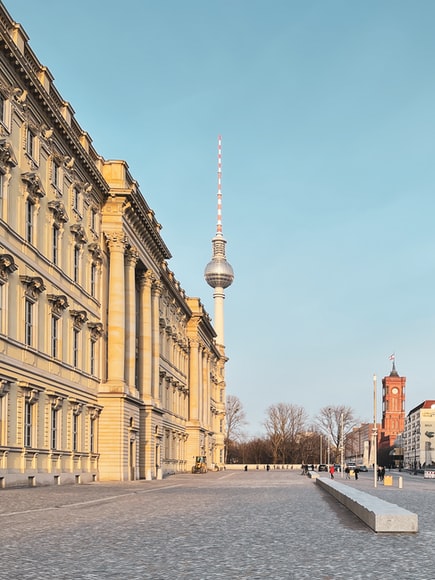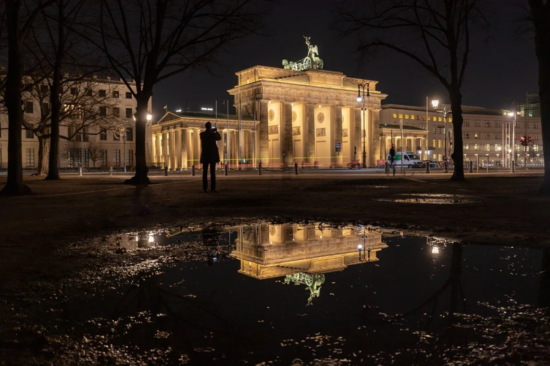Unter den Linden
Moving west from Spree Island towards the Brandenburg Gate and Tiergarten, we can walk across the most famous boulevard of the German capital known as Unter den Linden, a major attraction in itself. Berlin’s Champs-Élysées has developed from a bridle path into one of the top addresses in the city – and into a true tourist highway.
After all, it is the connecting line between the Berlin Cathedral and the Brandenburg Gate. But that is by far not all that the 1.5 kilometers-long and the 60-meter-wide road has to offer.
There are more historical buildings and monuments here than one can count but let’s start from the beginning. Elector Johann Georg had a bridle path laid out from the city palace to Spandau for the first time in 1573. This led via Lietzow, to what is today Charlottenburg. Elector Friedrich Wilhelm paved the way in 1647 and had the first linden trees planted.


During this time it was called “First Street”. The development on the street increased particularly in the years 1674 to 1737. During the German Empire, the residential street was turned into a shopping street with hotels and restaurants. From 1674 to 1690 the street was called Neustädtische Allee, then Lindenallee – until 1723 and finally it was named Lindenstraße until 1734.
Lustgarten (the word translates into the pleasure garden) based on the Dutch model was laid out for the first time in 1646. It is located between the Altes Museum and the Berlin Cathedral.
The National Socialists turned this square into a parade forum in 1934 and paved it. So it was then used for the first time until a renovation was pending in the 1990s, which again made a green and garden area out of the square. The area is still one of the most traditional places in Berlin, which is visited by many tourists and Berliners.
In 1701 Frederick the Great pushed ahead with the further expansion of the road. That is why the equestrian statue of “Old Fritz” can be found at the eastern end. This memorial was unveiled in 1852 but walled up again during World War II. In 1950, during the GDR era, the “Old Fritz” was dismantled and rebuilt in 1960 in Potsdam’s Sanssouci Park. In 1980 the memorial was finally returned to its original location.
After the old Berlin fortifications had been torn down, a new complex was built in 1740 at the request of Friedrich II. The Forum Fridericianum was to be a new, completely paved square in the city center. The commissioned architect Georg Wenzeslaus von Knobelsdorff, who incidentally was one of the most influential builders in Berlin, could not complete the planning of the square. This is why there was only the opera building at first.
Then the square was simply called Opera Square. However, this name would not last. The square was named in 1947 after the SPD politician August Bebel and is therefore now known as “Bebelplatz”.


The most significant buildings of the Bebelplatz are the State Opera, there is also the Alte Bibliothek (Old Library), the Prinzessinnenpalais (today the Palais Populaire a groundbreaking international forum for art, culture, and sports owned by the Deutsche Bank), St. Hedwig’s Cathedral, the Hotel de Rome and the Old Palace.
In the years 1748 to 1766, the Palais of Prince Heinrich was built for the Forum Fridericianum on today’s Bebelplatz. This should be a new royal palace, which can be guessed by the facade.
The Friedrich Wilhelms University was founded, which took over the building seven years after the prince’s death and began teaching in 1810. At that time it was still called the “Royal Friedrich Wilhelm University of Berlin”. During the Second World War, the building was almost destroyed and had to be reconstructed again.
In 1949 the university was renamed after its founder Wilhelm and his brother Alexander von Humboldt. In 1933, more than 20,000 books by well-known writers were burned on Bebelplatz by the National Socialists the square. The State Library was built by Ernst von Ihne between 1903 and 1914. It is one of the most important libraries in the world. Since 2005 it has been extensively renovated and repaired. There was a digital reopening in January 2021.



The Neue Wache has always been a memorial. The most famous architect in Prussia at the time, Karl Friedrich Schinkel, built the building for those who died in the Napoleonic Wars and the Wars of Liberation. That was his first work in Berlin.
Until the end of the monarchy in 1918, the building served as a guard house for the royal guard. Heinrich Tessenow was responsible for redesigning the Neue Wache in 1931 as a memorial for those who fell in the World War. This was badly damaged by bombs before the end of World War II.
The restored building has been a memorial to the victims of fascism and militarism since 1960. Since 1993, the Neue Wache has served as the Federal Republic of Germany’s central memorial for the victims of war and tyranny. At the western edge of Unter den Linden the world-famous landmark of Berlin, the Brandenburg Gate.





